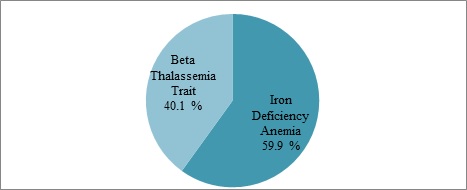Evaluation of the diagnostic reliability of Mentzer index for Beta thalassemia trait followed by HPLC
Abstract
Introduction: The individuals having thalassemia trait usually have an asymptomatic course and have mild microcytic hypochromic anemia. Since the other cause of microcytic anemia is iron deficiency, it is important to differentiate it from ???? thalassemia trait. Though the definitive diagnosis of thalassemia trait is possible only by HPLC, the Mentzer index is such an index that can differentiate between thalassemia trait and iron deficiency anemia.
Objectives: This study aims at figuring out the diagnostic value and reliability of the Mentzer index in the differentiation of iron deficiency anemia and thalassemia carrier compared with the results of HPLC.
Methods: This was a hospital-based retrospective observational study done on 1236 patients of all age groups. Mentzer index of all the patients was calculated and the results were analyzed and further compared with HPLC.
Results: Out of 1236 patients, 741 (59.9%) patients are of iron deficiency anemia and 495 (40.1%) patients are of β thalassemia trait. Mentzer index was found to be more reliable to detect true positive cases for β thalassemia trait with a sensitivity of 89.0%, specificity of 87.9%. Positive predictive value for β thalassemia trait is 83.2% and Negative predictive value is 92.3% with Youden’s Index 76.9.
Conclusion: Iron deficiency anemia and thalassemia have different effects on blood indices. In resource-poor and developing countries like that of India, it can be used as a screening tool. In doubtful cases, the diagnosis can be confirmed by HPLC.
Downloads
References
Rathod DA, Kaur A, Patel V, Patel K, Kabrawala R, Patel V, et al. Usefulness of cell counter-based parameters and formulas in detection of β-thalassemia trait in areas of high prevalence. Am J Clin Pathol. 2007;128(4):585-589. doi: https://doi.org/10.1309/R1YL4B4BT2WCQDGV.
Shivashankara AR, Jailkhani R, Kini A. Hemoglobinopathies in Dharwad, North Karnataka:a hospital-based study. J Clinic Diagnos Res. 2008;2:593-599.
Yates AM, Mortier NA, Hyde KS, Hankins JS, Ware RE. The Diagnostic Dilemma of Congenital Unstable Hemoglobinopathies. Pediatric blood & Cancer. 2010;55(7):1393-1395. doi: https://doi.org/10.1002/pbc.22702.
Mousa AO. Types of Anemias with Low MCV Using Mentzer Index and RBC Count among Patients Seen in Basrah Al-Sadir Teaching Hospital. Med J Babylon. 2014;11(2):292-296.
Sharma AK, Mehta S, Sharma S. Utility of Erythrocyte Indices for Screening of β Thalassemia Trait In Pregnant Women Attending Antenatal Clinic. Int J Med Sci Educat. 2016;3(4):331-337.
Health Technology Assessment Indonesia. Pencegahan Thalassemia. Kementrian Keseharatan RI 2010.
Galanello R (co-ordinating editor). Prevention of Thalassaemias and other haemoglobin disorders. Nicosia: Thalassemia International Federation 2003.
Lafferty JD, Crowther MA, Ali MA, Levine M. The evaluation of various mathematical RBC indices and their efficacy in discriminating between thalassemic and non-thalassemic microcytosis. Am J Clinic Pathol. 1996;106(2):201-205. doi: https://doi.org/10.1093/ajcp/106.2.201.
Patel AG, Shah AP, Sorathiya SM, Gupte SC. Hemoglobinopathies in South Gujarat population and incidence of anemia in them. Indian J Human Genet. 2012;18(3):294-298. doi: https://doi.org/10.4103/0971-6866.107979.
Brancaleoni V, Di Pierro E, Motta I, Cappellini MD. Laboratory diagnosis of thalassemia. Int J Lab Hematol. 2016;38(1):32-40. doi: https://doi.org/10.1111/ijlh.12527.
Sirachainan N, Iamsirirak P, Chaiyong C, Charoenkwan P, Kadegasem P, Sasanakul W et al. New Formula for the Differentiation Between Iron Deficiency Anemia and Thalassemic Carrier in Thalassemic Prevalence Areas: A Study in Healthy School-Age Children. Blood.2009;114(22):1410. doi: https://doi.org/10.1182/blood.V114.22.1410.1410.
Ehsani MA, Shahgholi E, Rahiminejad MS, Seighali F, Rashidi A. A new index for discrimination between iron deficiency anemia and beta-thalassemia minor: results in 284 patients. Pak J Biol Sci. 2009;12(5):473-475. doi: http://dx.doi.org/10.3923/pjbs.2009.473.475.
Ghafouri M, Sefat ML, Sharifi L. Comparison of cell counter indices in differentiation of beta thalassemia trait and iron deficiency anemia. Sci J Iran Blood Transfus Organiz. 2006;(2):385-389.
Batebi A, Esmailian R. Discrimination of beta-thalassemia minor and iron deficiency anemia by screening test for red blood cell indices. Turk J Med Sci. 2012;42(2):275-280. doi: https://doi.org/10.3906/sag-0909-294.
Bain BJ. Screening of antenatal patients in a multiethnic community for thalassaemia trait. J Clin Pathol. 1988;41(5):481-485. doi: https://dx.doi.org/10.1136%2Fjcp.41.5.481.
Demir A, Yarali N, Fisgin T, Duru F, Kara A. Most reliable indices in differentiation between thalassemia trait and iron deficiency anemia. Pediatr Int. 2002;44(6):612-616. doi:https://doi.org/10.1046/j.1442-200x.2002.01636.x.
AlFadhli SM, Al-Awadhi AM, AlKhaldi D. Validity assessment of nine discriminant functions used for the differentiation between Iron deficiency anemia and thalassemia minor. J Trop Pediatr. 2007;53(2):93-97. doi: https://doi.org/10.1093/tropej/fml070.
Mentzer Jr WC. Differentiation of iron deficiency from thalassaemia trait. The Lancet 1973;7808(1):882. doi: https://doi.org/10.1016/s0140-6736(73)91446-3.
Shine I, Lal S. A strategy to detect ???? thalassaemia minor. The Lancet 1977;8013(1):692-694.
England JM, Fraser PM. Differentiation of iron deficiency from thalassaemia trait by routine blood-count. The Lancet. 1973;7801(1):449-452. doi: https://doi.org/10.1016/s0140-6736(73)91878-3.
Schriever H, Srivastava PC. Differentiation of thalassaemia minor from iron deficiency. The Lancet. 1973;302(7821):154-155.
Green R, King R. A new red cell discriminant incorporating volume dispersion for differentiating iron deficiency anemia from thalassemia minor. Blood Cells. 1989;15(3):481-495.
Ricerca BM, Storti S, d'Onofrio G, Mancini S, Vittori M, Campisi S, et al. Differentiation of iron deficiency from thalassaemia trait: a new approach. Haematol. 1987;72(5):409-413.
Sirdah M, Tarazi I, Al EN, Al RH. Evaluation of the diagnostic reliability of different RBC indices and formulas in the differentiation of the beta-thalassaemia minor from iron deficiency in Palestinian population. Int J Lab Hematol. 2008;30(4):324-330. doi: https://doi.org/10.1111/j.1751-553X.2007.00966.x.
Telmissani OA, Khalil S, Roberts GT. Mean density of hemoglobin per liter of blood: a new hematologic parameter with an inherent discriminant function. Lab Haematol.1999;5:149-152.
El-Agouza I1, Abu Shahla A, Sirdah M. The effect of iron deficiency anaemia on the levels of haemoglobin subtypes: possible consequences for clinical diagnosis. Clin Lab Haematol. 2002;24(5):285-289. doi: https://doi.org/10.1046/j.1365-2257.2002.00464.x.

Copyright (c) 2020 Author (s). Published by Siddharth Health Research and Social Welfare Society

This work is licensed under a Creative Commons Attribution 4.0 International License.


 OAI - Open Archives Initiative
OAI - Open Archives Initiative


